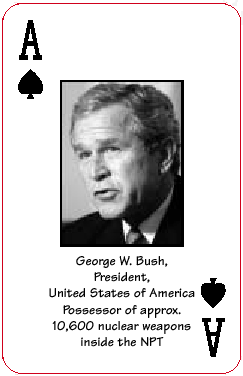 |
Highlights |
 |
|
 |
| Home > Features > Details
|
| Weapons of Mass Destruction
found! |
Zoom on Doom: Easy-to-find nuclear
weapons map
|
| Wed 30 April 2003 |
| NETHERLANDS/Amsterdam |

|
| Since the US and the UK are having
such a hard time finding weapons of mass destruction in Iraq,
we thought we'd lend a hand by providing this easy guide to
the nukes we know about. |

|
UN Weapons Inspectors and citizen weapons
inspectors are welcome to use our map to check up on just
where those elusive Weapons of Mass Destruction have been
hiding.
All information about these locations has been
drawn from public sources, so we didn't have to worry about
invading any countries, incurring civilian casualties, paying
costly bounties for inside information or mess around with
torture or illegal detention.
And here's the best part:
if the US and the UK want to dismantle some WMDs, they don't
need to go on costly excursions to foreign countries. We found
plenty in their own backyards.

You can
view the map by clicking here.
Requires Macromedia
Flash
For the next two weeks, the parties
to the Nuclear Non-Proliferation Treaty (NPT) will be meeting
in Geneva. Under the terms of that 1970 accord, the world's
non-nuclear weapons states agreed to stay that way. In
exchange, the countries that fessed up to owning nuclear
weapons at the time agreed to get rid of them.
We hope
the delegates to the NPT will have a quick look at the map to
easily identify the "bad guys" who haven't been disarming as
they promised. (Clue: there are a lot of
little radiation symbols in France, the US, China, Russia,
and the UK.)
After a careful review of available data,
you too can confirm the blindingly obvious: none of the NPT's
Nuclear Five have done very well in scaling back their nuclear
arsenals. They've failed utterly to eliminate them. If the
nuclear powers are seriously concerned about the WMDs of
India, Pakistan, Israel, and Korea, they ought to look to the
example they set.
Now call us old fashioned, but we
believe that a key lesson of the Iraq crisis is that
international laws and treaties to prevent proliferation must
be strengthened, not weakened. All of us who marched against
the Iraq war want to see the North Korean crisis and future
proliferation problems solved by negotiation, not pre-emptive
military strikes. "In the long run, the most effective means
to halt proliferation is the rule of law applied universally
and even-handedly to all states, not unilateral gunboat
diplomacy," says William Peden, of Greenpeace International's
disarmament campaign.
The NPT declares disarmament the
international norm - 182 of its 187 members have pledged never
to acquire nuclear weapons. But some of those states, such as
Brazil, are becoming increasingly aggravated with the failure
of the Nuclear Five to live up to their part of the bargain.
North Korea recently left the treaty regime and has declared
itself to be a nuclear power.
 Greenpeace
activists
dressed as missiles appeared at the missions of the
nuclear weapons states in Geneva as the meeting began to
demand "inspectors" symbolically dismantle the cardboard
arsenals. Greenpeace also issued a deck
of cards with the pictures of the known nuclear "bad guys"
to provide guidance to the NPT delegates about who needed to
disarm. Greenpeace
activists
dressed as missiles appeared at the missions of the
nuclear weapons states in Geneva as the meeting began to
demand "inspectors" symbolically dismantle the cardboard
arsenals. Greenpeace also issued a deck
of cards with the pictures of the known nuclear "bad guys"
to provide guidance to the NPT delegates about who needed to
disarm.
Here's what we want to see out of this round of
the NPT:
- North Korea should abandon the pursuit of nuclear
weapons and rejoin the NPT.
- States should reject the use of military force to
resolve proliferation concerns, and uphold the value of
multilateral legal mechanisms.
- States should reject the "first strike" use of nuclear
weapons, and agree legally binding security assurances.
- All nuclear weapon states should commit to the goal of
eliminating their illegal nuclear arsenals and halting the
development of new nuclear weapons or the "refurbishment" of
existing ones.
- States should agree an emergency mechanism to deal more
swiftly and effectively with future crises such as North
Korea's withdrawal from the NPT.
- The promotion of "dual use" nuclear technology,
particularly reprocessing and enrichment technologies, which
is permitted under the NPT, should be stopped and a
comprehensive ban on the production and use of all fissile
material agreed.
If there are nuclear weapons of
mass destruction in Iraq, we hope the right people find them.
But we're not exactly sure who the right people would be,
given their mission ought to be something the US and UK are
not very good at: dismantling them.
For more information about the NPT
prepatory meeting, you can read a detailed
briefing here.
==========================
Map
Sources include: Deadly Arsenals: tracking weapons of mass
destruction, Joseph Cirincione with Jon B Wolfsthal and Miriam
Rajkumar, Carnegie Endowment for International Peace. http://www.globalsecurity.org/wmd/index.html
http://www.fas.org/nuke/guide/index.html
http://www.thebulletin.org/issues/nukenotes/nukenote.html
|
| |
 |
 |
February, 2003: Greenpeace
'weapons inspector' outside the U.S. embassy in
Spain.
|
 |
 |
 |
|
 |
| |

|
|
 |
Chemical consumers?...More |
Paper imports may Finnish the forest...More |
Illegal logging in Cameroon...More | 
|
|
Genetic engineering stuck in Dark
Ages...More |
Global voices say no to war...More | | 

 |
Sign up! |
 |
 |



